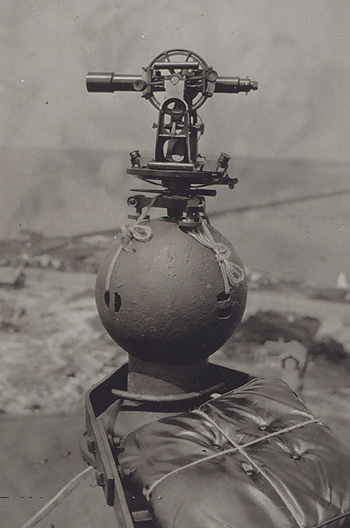 Thomas Jefferson's Theodolite
Thomas Jefferson's Theodolite Hassler's Camp
Hassler's Camp The Great Theodolite
The Great Theodolite Würdemann Six-inch Theodolite
Würdemann Six-inch Theodolite Heliotrope
Heliotrope Micrometer Scale
Micrometer Scale Theodolite Mounted on Water Tank
Theodolite Mounted on Water Tank Seven-inch Repeating Theodolite
Seven-inch Repeating Theodolite C&GS Twelve-inch Theodolite
C&GS Twelve-inch Theodolite Wild T-4
Wild T-4 K&E Theodolite, Parkhurst Design
K&E Theodolite, Parkhurst Design Wild T-2
Wild T-2 Wild T-3
Wild T-3 Topcon GPT-3002LW Total Station
Topcon GPT-3002LW Total Station
Theodolite Mounted on Water Tank
When it came to surveying, the sky was the limit! This photo, taken in 1926, shows a theodolite carefully mounted on top of a water tank in New Jersey.

Accurate and precise doesn't always mean conventional! The theodolite shown in this image was mounted on top of the Seaside Park Water Tank in New Jersey. With the theodolite stable, leveled, and the appropriate specifications followed, high-accuracy observations could well have been obtained from the site. Note that a cushion was taken along to add some comfort to the high perch. Also note that the photographer didn't step too far back when he took the picture!
Historical Reference
The Coast and Geodetic Survey (C&GS) followed the lead of its first Superintendent, Ferdinand Hassler, in seeking to produce the highest accuracy work possible in a consistent and repeatable manner. As part of its mandate, C&GS developed standards and specification guidelines and made them available to assist surveyors in obtaining consistently good results from their surveys.
A 1980-version of those guidelines, "Specifications to Support Classification, Standards of Accuracy, and General Specifications of Geodetic Control Surveys," defines the various orders of surveys:
- - Super First-order, 1:1,000,000 accuracy, or one inch (2.5 centimeters) of error for every 1,000,000 inches (25,400 meters);
- - First-order, 1:100,000 accuracy;
- - Second-order, class I, 1:50,000;
- - Second-order, class II, 1:20,000; and
- - Third-order class I and II, 1:10,000 and 1:5,000, respectively.
Each level of accuracy required a minimum number of sets of observations: first-order required 16 direct and 16 reverse observations for a total of 32 angles read. This redundancy helped to prevent errors from slipping through. In order to reduce chances of errors in the circle affecting the observations, observations were made from different settings around the circle; these circle settings are defined for each order and class of observation.
- Instrument Shown: Theodolite, type unknown
- Location: New Jersey
- Manufacture Date: Mid-1800s to early 1900s
- Dates of Use: Mid-1800s to early 1900s
- Photo Date: 1926
Works Consulted
Federal Geodetic Control Committee. (1980). Specifications to Support Classification, Standards of Accuracy, and General Specifications of Geodetic Control Surveys. Rockville, MD: National Ocean Survey.
